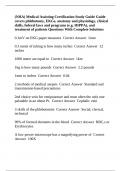(NHA) Medical Assisting Certification Study Guide Guide
covers phlebotomy, EKGs, anatomy and physiology, clinical
skills, federal laws and programs (e.g. HIPPA), and
treatment of patients Questions With Complete Solutions
0.1mV on EKG paper measures Correct Answer 1mm
0.3 meter of tubing is how many inches Correct Answer 12
inches
1000 meter are equal to Correct Answer 1km
1kg is how many pounds Correct Answer 2.2 pounds
1mm to inches Correct Answer 0.04
2 methods of medical asepsis Correct Answer Standard and
transmission-based precautions
2nd choice vein for venipuncture and most often the only one
palatable in an obese Pt. Correct Answer Cephalic vein
3 skills of the phlebotomist Correct Answer Social, clerical,
technical
99% of formed elements in the blood Correct Answer RBC,s or
Erythrocytes
A low power microscope has a magnifying power of Correct
Answer 100X
,A muscular hollow organ located in the thoracic cavity between
lungs Correct Answer Epicardium
A positive holter is one that recorded at least one or more of
these abnormalities Correct Answer Tachy, bradycardia, ST
segment elevation or depression, and pauses
A positive urine nitrate test is an indication for Correct Answer
A significant number of bacteria are present
A urine pH of what is considered neutral? Correct Answer 7.0
pH
Abbreviation for decimeter Correct Answer dm
Abbreviation of microliter Correct Answer ul
ABG, ammonia, lactic acid, pyruvate, parathyroid test handling
Correct Answer Chilled in crushed ice and water mixture
Acts a pacemaker when higher level pacemakers fail Correct
Answer Purkinjie fibers
Additives in a green top tube Correct Answer Heparin, sodium,
lithium, ammonium
Agents are Correct Answer Any infective microorganisms,
viruses, fungi, bacteria, and parasites
Analytical errors After collection of blood Correct Answer
Failure to separate serum from cell (Glycolisis), improper use of
,serum separator (Not inverting tubes or not spinning tubes),
delays in processing, exposure to light, improper storage
conditions, dimming clots
Analytical errors before collection of blood Correct Answer
Patient misidentification, improper time, wrong tubes, not
fasting, exercise (Cortisol levels), Pt. Posture, Poor coordination
with other treatments, improper site prep, medication
interference
Analytical errors during collection of blood Correct Answer
Extended tourniquet time, hemolysis, wrong order of draw,
failure to invert tubes, faulty technique under filling tubes
Anthropometric measurements Correct Answer BMI and
growth development in infants, children, and adults
Antiseptic not used on a dermal puncture site Correct Answer
Betadine (Because it interferes with several tests like bilirubin,
uric acid, phosphorus, and postassim)
Antiseptics used in Phlebotomy Correct Answer 70% isopropyl
alcohol pads most common, provolone - iodine for BC,s and
Chlorhexidine gluconate for patients that are allergic to
Betadine/ Iodine
Arteries supplying the heart Correct Answer Right and left
coronary from the aorta
Automaticity Correct Answer Ability of the cardiac cells to
initiate own electrical impulses without outside stimulation
, Average gauge of needle used for drawing blood Correct
Answer 21-22
Axillary temperature range in Celsius Correct Answer 35.9-
37.0 C
Bacteria that are decolorized completely by ethanol and take
safrin counterstain Correct Answer Gram negative bacteria,
appear red
Bacteria that take up and retain the crystal violet and resist
alcohol discoloration Correct Answer Gram positive bacteria,
appear blue to black
bid Correct Answer Twice a day
Bili Correct Answer Bile
Blood vessels Correct Answer Aorta, Arteries, Arterioles,
Capillaries, Venues, Veins, Superior and Inferior Vena Cavae
Boiling water in today's medical environment is limited to items
that Correct Answer Will not be used in invasive procedures,
will not be interested inside the body nor in sterile procedures
BP cuffs too short and narrow can give a false reading of what?
Correct Answer Hypertension
Butterfly Correct Answer Winged infusion set




